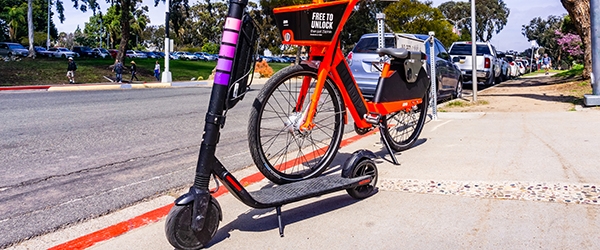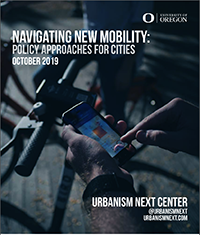Emerging Technologies in Mid-Size Cities: Managing New Mobility

- Download the Final Report (PDF)
- Download the Project Brief (PDF)
- Register for the Jan 22, 2020 webinar
- See a slideshow on "Emerging Technologies and Cities" presented by Becky Steckler at the 2019 OAPA Annual Conference in Eugene, OR
- Download the guidebook "Navigating New Mobility: Policy Approaches for Cities" (PDF)
What was once purely science fiction is starting to materialize on streets across the country. Advances in emerging technologies – such as autonomous vehicles (AVs), e-commerce, and the sharing economy – are having profound impacts, negative and positive, on how people and goods move around a city and are beginning to have substantial effects on land use, street design, parking, and housing.
In response to these changes, both the cities of Gresham and Eugene, Oregon are developing micromobility (e.g. bike share and e-scooter share) and TNC (transportation network company, e.g. Lyft and Uber) policies, regulations, and revenue guidance. In order to help the cities of Gresham and Eugene navigate these challenges and opportunities, the University of Oregon's Urbanism Next Center partnered with the cities through the university's Sustainable City Year Program (SCYP). Through this work, UO researchers and students helped these communities understand the potential impacts of new mobility technologies and to prepare a policy and programmatic response
While Gresham and Eugene were case studies for this research, the final report (PDF) provides useful information for any mid-sized community on how new mobility services could impact their communities and what they can do about it. This work focused on the new mobility and goods delivery services that currently exist, but the framework is also applicable to emerging technologies that haven’t yet been introduced, such as autonomous vehicles (AVs). We're hosting a webinar on January 22 focused on the impacts of new mobility on mid-sized cities and policy takeaways.
POLICY APPROACHES FOR CITIES
To see the high-level policy recommendations for city staff, download the guidebook "Navigating New Mobility: Policy Approaches for Cities" (PDF). For the nitty gritty on the project's background, data analysis, specific case studies, and the researchers' framework, approach and methodology, go to the final report (PDF). Each offers detailed recommendations for how cities should address the following areas of priority in their new mobility plans:

Safety
Social Equity
Active Transportation
Environmental Quality
Reducing Vmt And Congestion
Adapting Right-of-way Design And Management
Changes In Land Use And Metropolitan Footprint
Requiring Information To Make Informed Decisions
Managing Innovation
Fiscal Impacts
NEW MOBILITY STRATEGY: BEGIN WITH COMMUNITY VALUES
The most effective strategies begin with well-articulated goals. City staff and leaders should ensure that values – not technology – shape policies. Each city should consider developing a new mobility strategy which clearly describes desired outcomes to guide changes in the transportation system.
The Cities of Eugene and Gresham each have an ongoing Transportation System Plan and other plans in place which outline community values and goals. Researchers recommend that new mobility and e-commerce policies address the following areas of value:
- Safety (reduced fatalities and serious crashes)
- For example, a course of action related to safety could mean more aggressively protecting pedestrians and bicyclists by restricting the use of e-scooters on sidewalks and building protected bike lanes to keep delivery vehicles and automobiles from obstructing bicyclists.
- Equity (a fair and just transportation system for all)
- For example, requiring new mobility services to offer diverse payment options that let people pay without a smartphone or credit card.
- Public Health (low-carbon, active transportation options)
- In the context of public health and new mobility, there is potential to improve active transportation options by repurposing existing parking for other modes and uses.
- Sustainability (reduced GHG emissions)
- For example, one way that cities are looking to reduce VMT from new mobility services is to encourage the use of shared vehicles over zero- or single-occupancy vehicle.
COORDINATE WITH REGIONAL PARTNERS
Both Gresham and Eugene are part of larger regions – Gresham is a suburb to Portland and Eugene is the anchor city to a number of smaller bedroom communities. The cities should consider regional data analysis and policies that could help all jurisdictions prepare for the deployment of services.
DATA MANAGEMENT
More and more, public agenciesare requiring information from transportation service providers to ensure that they understand the impacts of the service. Public agencies have always collected transportation data, but the possibility of new data sources, either from data aggregators like Sidewalk Labs, or the transportation service providers themselves, means that local governments may have access to much more data—and potentially real-time data—that they haven’t had before. In order to analyze this data, cities and other public agencies will need to make sure they have:
- The technical expertise to analyze the data (which has staffing implications);
- Privacy policies in place and a process to ensure that individual privacy can be protected.
TRANSPARENCY
Decision makers and residents should have access to all the information they need to understand how emerging technologies are impacting their cities. City staff should consider how they will introduce these topics and how they will continue to keep elected officials and citizens informed over time.
WORKING WITH THE SUSTAINABLE CITY YEAR PROGRAM
The Sustainable City Year Program at the University of Oregon is a groundbreaking educational model began in 2009 with seed funding from OTREC, the predecessor of NITC. Today this experiential learning model is being adopted by universities across the country. Through year-long partnerships, the program helps communities solve the problems of today and lay the groundwork for a sustainable, livable future—all while helping students prepare for the workforce through applied learning.
The bulk of the research for this project was done by eight University of Oregon classes, with participation by 147 students in the 2018/2019 school year. You can review their planning documents below.
- Course: Public Management; Ben Clark, instructor
- New Mobility in Gresham: Recommendations and Guidelines
- Report authors: Agraj Dangal, Sarah Reiter and Delaney Wood; Master Of Public Administration Program
- Open Data Management and Policies in Eugene
- Report authors: Sam Ault, Eric Burdette, Arron Cobb and Amelia Rhodewalt; Master Of Public Administration Program
- Course: Land use Planning; Yizhao Yang, instructor
- Community Strategies to Improve Accessibility and Sustainable Transportation in Downtown Eugene
- Report authors: Emerson Hoagland and Rj Theofield; Community And Regional Planning Program
- Course: Masters of Public Administration Capstone; Ben Clark, instructor
- Transportation Policy Options: New Mobility Services and Autonomous Vehicles
- Report authors: Stacie Duffey, Grace Park and Michael Thomas; Master Of Public Administration Program
- Course: Future of Urban Design and Planning, Advanced Design Studio; Rob Ribe, instructor
- Exploring New Mobility Street Designs for a Suburban Downtown in Transition
- Report author: Tshewang Tamang; Landscape Architecture Program
- Course: Growth Management; Rebecca Lewis, instructor
- Future-Proofing Comprehensive Plans in Eugene and Gresham
- Report author: Jennifer Kohnke; Community And Regional Planning Program
- Course: Transportation Planning; Anne Brown, instructor
- Planning for a New Mobility Future
- Report Author: Carol Crum; Planning, Public Policy, And Management Undergraduate Program
- Course: Public Budget Administration; Rebecca Lewis, instructor
- Transportation Revenue in the Age of New Mobility
- Report author: Michele Stark; Public Administration Program
- Course: Industrial Ecology; Joshua Skov, instructor
- New Mobility Case Study
- Report author: Rachel Cohen; Master Of Business Administration Program
This research was funded by the National Institute for Transportation and Communities, with additional support from the National Science Foundation, the University of Oregon's Urbanism Next and Sustainable City Year programs, and the Cities of Eugene and Gresham, Oregon.
RELATED RESEARCH
To learn more about this and other NITC research, sign up for our monthly research newsletter.
- How Will Autonomous Vehicles Change Local Government Budgeting and Finance? A Case Study of Solid Waste, Drop-off/Pick-up Zones, and Parking
- Incorporate Emerging Travel Modes in the Regional Strategic Planning Model (RSPM) Tool
- Community-based Assessment of Transportation Needs to inform City of Portland Smart Cities Plan
The National Institute for Transportation and Communities (NITC) is one of seven U.S. Department of Transportation national university transportation centers. NITC is a program of the Transportation Research and Education Center (TREC) at Portland State University. This PSU-led research partnership also includes the Oregon Institute of Technology, University of Arizona, University of Oregon, University of Texas at Arlington and University of Utah. We pursue our theme — improving mobility of people and goods to build strong communities — through research, education and technology transfer.
